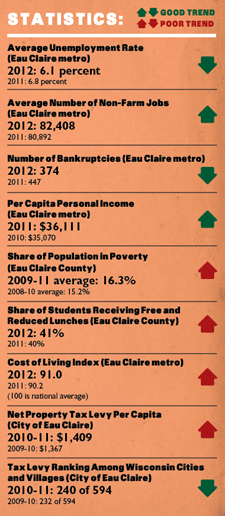Personal Economics
|
While the Chippewa Valley’s economic development picture last year was generally positive, things were cloudier when it came to pocketbook economic indicators. Some measurements did improve, notably the unemployment rate, which fell to an annual average of 6.1 percent last year (behind only Madison and La Crosse among Wisconsin metro areas). The number of new unemployment claims also fell in 2012 (although that may mean some people stopped looking for work). Likewise, the number of personal bankruptcies fell and the per capita personal income rose by 3 percent in 2011 (the most recent year for which numbers are available). However, as they have for many years, incomes still lag in the Chippewa Valley: In terms of per capita personal income, the regional ranked second-to-last among Wisconsin’s 12 metro areas (only Janesville was worse), and it ranked third-to-last for household income (ahead of Oshkosh and Janesville). Part of that is because of the region’s high concentration of poorly paid college students, but there are other factors, too. “Something that will also tend to lower our wages is we’re a retail hub,” says Scott Hodek of the Wisconsin Department of Workforce Development. “We don’t have a lot of headquarters operations, and that’s where you see a lot of the big wages.” That having been said, things may be looking up when it comes to income: Between 2007 (the year the Great Recession officially began) and 2011, the Eau Claire metro area showed the second-best income growth in the state. “We don’t have a lot of headquarters operations, and that’s where you see a lot of the big wages.” Low wages also meant high poverty: The share of Eau Claire County residents in poverty grew between 2008-10 and 2009-11, as did the number of people in the FoodShare program (i.e., food stamp recipients) and the share of students qualifying for free and reduced-price lunches. On the brighter side, for the most part it’s cheap to live here. A national group, the Council for Community and Economic Research, produces a cost of living index based on the price of everything from hamburgers to haircuts in metro areas nationwide, and for 2012 the Eau Claire metro area had a composite index of 91 (with 100 being the national average). That means goods and services here are an average of 9 percent cheaper than they are nationwide. By the same token, however, it’s important to remember that per capita income here is 87 percent of the national average, meaning a gap between pay and buying power remains. |
Grading Guide:
Having a low cost of living and low unemployment only helps so much because incomes here continue to lag far behind the state and nation. The Valley needs more good-paying jobs to catch up. Rising poverty statistics indicate the recession never ended for many of our neighbors. Among all parts of the report card, this area needs the most improvement. |
Listen! Editor's Conference
![]()
Scott Hodek, regional economist, Wisconsin Department of Workforce Development; Eric Jamelske, UW-Eau Claire economics professor; Chippewa Valley Center for Economic Research and Development; U.S. Census Bureau; Wisconsin Department of Public Instruction; Wisconsin Department of Health Services; Council for Community and Economic Research; Wisconsin Taxpayers Alliance.




















